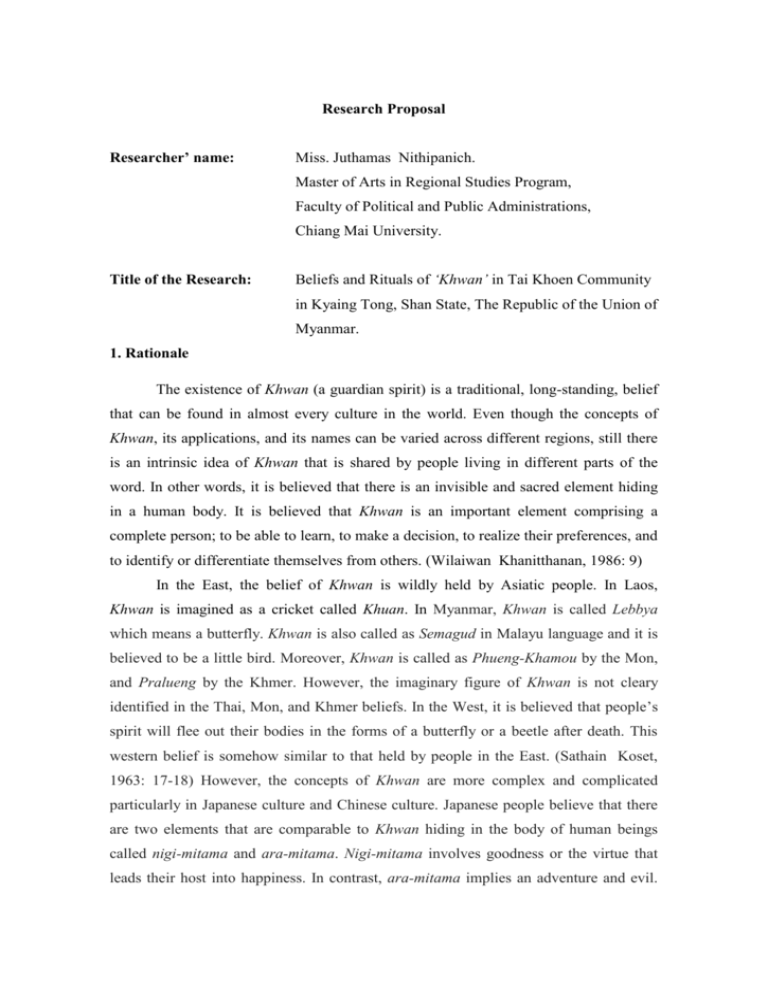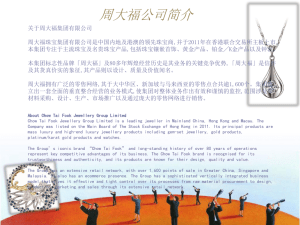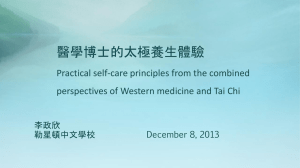Word - Intranet
advertisement

Research Proposal Researcher’ name: Miss. Juthamas Nithipanich. Master of Arts in Regional Studies Program, Faculty of Political and Public Administrations, Chiang Mai University. Title of the Research: Beliefs and Rituals of ‘Khwan’ in Tai Khoen Community in Kyaing Tong, Shan State, The Republic of the Union of Myanmar. 1. Rationale The existence of Khwan (a guardian spirit) is a traditional, long-standing, belief that can be found in almost every culture in the world. Even though the concepts of Khwan, its applications, and its names can be varied across different regions, still there is an intrinsic idea of Khwan that is shared by people living in different parts of the word. In other words, it is believed that there is an invisible and sacred element hiding in a human body. It is believed that Khwan is an important element comprising a complete person; to be able to learn, to make a decision, to realize their preferences, and to identify or differentiate themselves from others. (Wilaiwan Khanitthanan, 1986: 9) In the East, the belief of Khwan is wildly held by Asiatic people. In Laos, Khwan is imagined as a cricket called Khuan. In Myanmar, Khwan is called Lebbya which means a butterfly. Khwan is also called as Semagud in Malayu language and it is believed to be a little bird. Moreover, Khwan is called as Phueng-Khamou by the Mon, and Pralueng by the Khmer. However, the imaginary figure of Khwan is not cleary identified in the Thai, Mon, and Khmer beliefs. In the West, it is believed that people’s spirit will flee out their bodies in the forms of a butterfly or a beetle after death. This western belief is somehow similar to that held by people in the East. (Sathain Koset, 1963: 17-18) However, the concepts of Khwan are more complex and complicated particularly in Japanese culture and Chinese culture. Japanese people believe that there are two elements that are comparable to Khwan hiding in the body of human beings called nigi-mitama and ara-mitama. Nigi-mitama involves goodness or the virtue that leads their host into happiness. In contrast, ara-mitama implies an adventure and evil. 2 These two elements can flee out of their host anytime, and can startle their host by appearing, visibly, before the eyes of their host. In Chinese culture, it is believed that a human being is comprised of the two invisible elements; Hun and Poh. Hun conveys wisdom, and it is an immortal part of a human being. In contrast, Poh rather conveys a negative meaning. The combination of Hun and Poh is the key determinant of people’s personalities and characteristics. Moreover, Chinese people believe that there is another intrinsic element embedded in the body called Ching. Ching is defined as a person’s strength. Living without Ching, one can never be a completed person. Therefore, Chinese people often explain the death of their child as absence of Ching’s growth. In this sense, Hun and Ching play an important role in people’s personalities. The term Ching-hun alone means wisdom. After one has died, Hun will flee from the death body and turns into Shen, finding its way into heaven. On the other hand, Poh will turn into Kuei, wandering on the earth after their host has died. However, Ching is not mentioned in that case. (Wilaiwan Khanitthanan, 1986: 9-10) The belief associated with Khwan is considered as one of the most primitive beliefs among the Tai ethnicity since the term Khwan is collectively rooted in Tai language. In addition, the term Khwan is also used wildly by Tai people, no matter they live inside or outside the Tai state. The term Khwan is mentioned by Tai people in China, India, Myanmar, and Laos even though these Tai people are living apart in the different regions and have never contacted or communicated to one another. The reason is because the belief associated with Khwan is the primitive belief shared among the Tai ancestors and it has been passing onto their descendants from generation to generation. (Ranee Lertleumsai, 1996: 147) For example, Tai Lue people in Xishuangbanna, Chinese, Tai Khoen in Kyaing Tong (Kyaing Tong or Chiang Tung), Myanmar, and Tai Laos Laan Chang in Laos believe in Ya Khwan Kao (a rice goddess) and they occasionally deliver rituals or ceremonies in order to pay homage to the goddess such Bhucha Ya Khwan Kao (paying homage to the goddess), Su Khwan Kwai (a ceremony to show gratitude to the buffaloes), and Hag Na Khwan (the Plowing Ceremony). In additions, Tai Dam and Tai Khao in Vietnam believe that Tan is a determinant for people’s Khwan. They believe that there are 32 Khwans embedding within a human body. (Sirapohn Na Thalang, 1996:13-29) Among some groups of Tai people, it is 3 believed that up to 80 Khwans can be found in a person. (Srisak Wanlibhodom, 1991: 31) Even though Tai people who living in the different regions have never contacted or communicated to one another, but it is found that they are still carrying on the rituals or ceremonies associated with Khwan in various fashions. As the result of time change and the contexts shift founded among Tai people living in the different regions, some changes toward the primitive belief associated to Khwan can be seen. Of 2 majors changes can be clearly identify: 1. Dialectic change; the term Khwan is used in the Central Thai dialect. But, the term is called differently such as Khuan, Khon, or Phan in the different dialects. 2. Conceptual change; the extent of Khwan is believed and treated differently among Tai people living in the different regions. - On the one hand, Khwan is believed and treated similarly by the Tai people living outside the Thai territory such as China, India, and Myanmar. These Tai people believe that Khwan is something hiding in a human body, having no superstitious powers, and one cannot live as a normal person or cannot be a complete person without Khwan in their body. However, Tai people living outside Thailand believe that Khwan can still exist after the death of its host. This belief can be seen through the folklores, telling that Khwan will return home and contact with its host’s family after the death of its hosts. - In Thailand, Khwan is believed to exist only when its host is alive. Khwan will never be mentioned again after the host has died. Instead, the term that often mentioned after death is Winyan (spirit). However, the term Winyan is not applied for a living person. In this sense, Khwan and Winyan can be distinguished; Khwan relates to life, whereas Winyan relates to death. (Wilaiwan Khanitthanan, 1986: 16-17) As mentioned above, it can be concluded that Khwan is an invisible element hiding in every human being. One would be a normal person or a complete person if their Khwan is founded in their bodies. In contrast, something wrong might happen to the host if their Khwan has left. In that case, some rituals or ceremonies will be arranged in order to call their Khwan back into the host. After death, Khwan will never be mentioned among some groups of Tai people. But, some groups of Tai people believe that Khwan can still exist after its host has died. 4 Overall, the belief associated with Khwan is held and shared among people living in the Asiatic region, even though it is called differently and the ritual patterns associated with Khwan are slightly different in the different settings. For people living in South-East Asia, Khwan plays an important role affecting people’s mode of thought and the system of beliefs. The belief associated with Khwan is considered as the origin of several rituals and ceremonies to keep Khwan in a human body. It can be noticed that the ceremonies and rituals related to Khwan are normally taken place throughout Tai people’s lifespan. These rituals and ceremonies are the important functions of the Tai’s social system and culture. Therefore, it is crucial to study the belief patterns associated with Khwan among Tai ethnic people in order to understand their social system and their culture. Tai Khoen is a group of the Tai ethnic people that demonstrates a distinctive identity in terms of their history, culture, tradition, and their way of living. Tai Khoen is also unique in terms of dressing, housing, written and spoken language, as well as, their distinctive belief pattern. Tai Khoen scatters around the South-East Asia region, a great numbers of them can be found on the eastern basin of Salawin river; in Kyaing Tong, Shan State, The Union of Myanmar. Tai Khoen in Kyaing Tong shares a long history with Tai Lue in Xishuangbanna and Tai Yong in Yong State. Moreover, they also hold a long relationship with Tai Yuan in Lanna Kingdom. Their relationships greatly reflect through their culture, customs, history, politic, and marriage. Through the recorded history, the marriages between the members of ruling families of Lanna Kingdom and Kyaing Tong were taken place 3 times; The first time was the marriage between the son of JaoFaSamChai (the highest price SamChai) and princess SriKaew, the daughter of JaoBureerat (Lord Bureerat), the second time was the marriage between the son of JaoKaewNawarat, prince Inthanon Na Chaing Mai, and princess Sukantha the daughter of JaoFaRattana Konkaew In-thalang, The third marriage was held between JaoFaPromLue, the son of JaoFaRattanaKonkaewIn-thalang, and princess Tippawan Na Lampang, the duagther of JaoChaiyaSong-kram Na Lampang of Jao Jed Ton family (one of the greatest ruling families of Lanna Kingdom). The kinship system formed through these marriages created a significant relationship between the two kingdoms in a way that they helped each other when one was in trouble. (Chanwit Kasetsriri and Kanjana La-ongsri, 1998: 5 131-133) Moreover, the two kingdoms have a long history exchanging their culture, tradition, and customs. Thus, some similarity can be noticed through their spoken language, tradition, rituals and ceremonies, including their beliefs. It should be noted that, the identity, history, and culture of Tai Khoen in Kyaing Tong were once greatly preserved due to the social and political forces in Myanmar. Since Myanmar closed itself to the rest of the world, so Kyaing Tong was simultaneously closed for almost 30 years (from 1963 to late 1992). Nowadays, Myanmar’s government allow tourist to visit Kyaing Tong. The allowance has brought Kyaing Tong into contact with the outside world and other alien culture. As a result, Tai Khoen’s society, culture, tradition, and their way of life have been changed consequently. The above information reflects an important virtue of studying the belief and the ritual patterns associated with Khwan among Tai Khoen in Kyaing Tong, Myanmar. The study will ultimately shed light on understanding the roles and the significances of the belief and rituals associated with Khwan in the particular context of Tai Khoen, Kyaing Tong. Moreover, it will illuminate the factors associated with the existence and the changes concerned the beliefs and rituals held among the current Tai Khoen community in Kyaing Tong. In addition, the study will reveal the future trend toward the contextual change that might affect the way of life of Tai Khoen people in the future. 2. Research Questions 2.1 What are the belief patterns and the ritual patterns associated with Khwan among Tai Kheon people in Kyaing Tong, Myanmar? 2.2 What are the roles of rituals associated with Khwan in the social and cultural context of Tai Khoen in Kyaing Tong, Myanmar? 2.3 What are the changes and modifications in the belief and rituals being practiced among the Tai Khoen community in Kyaing Tong, Myanmar? 2.4 What are the key factors that influence the changes and modifications in the belief and rituals being practices among the Tai Khoen community in Kyaing Tong, Myanmar? 6 3. Objectives of the study 3.1 To study the belief patterns and the ritual patterns associated with Khwan among Tai Khoen people in Kyaing Tong, Myanmar. 3.2 To investigate and analyze the roles of rituals associated with Khwan in the social and cultural context of Tai Khoen in Kyaing Tong, Myanmar. 3.3 To explore and analyze the existence and the changes associated with the beliefs and rituals held among the current Tai Khoen community in Kyaing Tong. This understanding will ultimately reveal the future trend toward the contextual change that might affect the way of life of Tai Khoen people in the future. 4. Conceptual Framework Globalization -Social -Economic Key factors that influence the changes and modifications in the belief and rituals Belief and rituals associated with Khwan in Tai Khoen Community in Kyaing Tong, Shan State, Myanmar Roles and functions of belief and rituals of Khwan in Tai Khoen Community Trend toward the contextual change that might effect to way of life of Tai Khoen people 7 6. Scope and Limitation of Research. 6.1 Scope of area This research will collect the data from 4 Tai Khoen villages, Kyaing Tong, Shan state, Myanmar. The details are as followed; Since Kyaing Tong is a place where many ethnic groups inhabit together so, the researcher has to specifically collect the data from Tai Khoen village. From a survey to collect the fundamental data in an area of Chiang Mai where Tai Khoen people immigrants from Kyaing Tong are living in helps the researcher to know names of four Tai Khoen villages that can preserve most of their originality. These four villages are; (1) Phakham village (2) Nongla village (or Nongcha village) (3) Nonghong village (4) Nongbua village. These villages are the places where most tradition, culture, and life style of Tai Khoen are preserved. The data collection from these four villages allows the researcher to collect adequate data for the study result and data analysis. 6.2 Scope of study The researcher will collect the data about belief and rituals that concerned with Khwan. The form of rituals can be divided in to two main categories. ( 1 ) Rituals concerned with Khwan that are performed annually such as during Khao Pansa, the ritual is performed to family members or Khwan Kao ritual or Khwan Phra Mae Bhosop ritual that is performed before or after a rice farming season. (2 ) Rituals concerned with Khwan that are involved with people’s lives. These rituals are usually performed at the changing period of life such Khwan ritual for a new born baby, Khwan Duen ritual when a child is one-month old, Khwan ritual in the process of entering monkhood and Khwan ritual for bride and groom in a wedding ceremony. 8 BIBLIOGRAPHY Chanwit Kasetsriri and Kanjana La-ongsri. (1998). Xishuangbanna: A Conservative State. Bangkok: Fund Research Office, Social Science and Humanities Project Foundation. Nakorn Prang-rit, Jintana Mattayomburoot and Rungthip Glahan. (2009). Tradition for 12 Months in Kengtung. Chiang Mai: The Center for Buddhist Neighbors Studies, Education Department, Chiang Mai Campus, Royal College of Chulalongkorn University. Ngampit Satsanguan. (2008). Qualitative Research in Anthropology. Bangkok: Chulalongkorn University. On-siri Panin. (2005). Ecology and Layout of Tai-Khoen Villages in Chieng Tung. Na-juo. 21(2547 B.E.-2548 B.E.), 17-23. Bangkok: Faculty of Architecture, Silpakorn University. Patcharin Khongkhasurichai. (2003). An Analysis of Tham Khwan script of Tai Song, Khao-Yoi District, Petchaburi Province. Master of Arts Thesis (Thai), Srinakharinwirot University. Pittaya Fusai. (2006). Community Responses to Chinese Market in Mueang Houay Xai, Bokeo Province, Lao PDR. Master of Arts Thesis (Regional Studies Program), Graduate School, Chiang Mai University. Pra Palad Sanae Dhammawaro. (2007). Way of Life : Tai Khoen in Kyaing Tong. Chiang Mai : Moradok Lanna Press. Ranee Lertleumsai. (1996). Tai Ahom Myth. Master of Arts Thesis, Department of Oriental Languages, Graduated School, Silpakorn University. Srisak Wanlibhodom. (1996). Beliefs of ‘Tan’ in Tai Dam, a Traditional Religion of Thai. Muang Boran, 17(3)(July-September), 12-35. Sirapohn Na Thalang. (1996). The Study and Analysis of the Myth to Create the World In Tai Groups. Bangkok: Research and Development Institute, Sukhothai Thammathirat University. Sathain Koset. (1963). Khwan and Tradition of the Compensation. Bangkok: Rung-ruang-rat Press. Wilaiwan Khanitthanan. (1986). Evalution of ‘Khwan’ Ceremony in Tai Groups. Bangkok: Institute of Tai Studies, Thammasat University.









